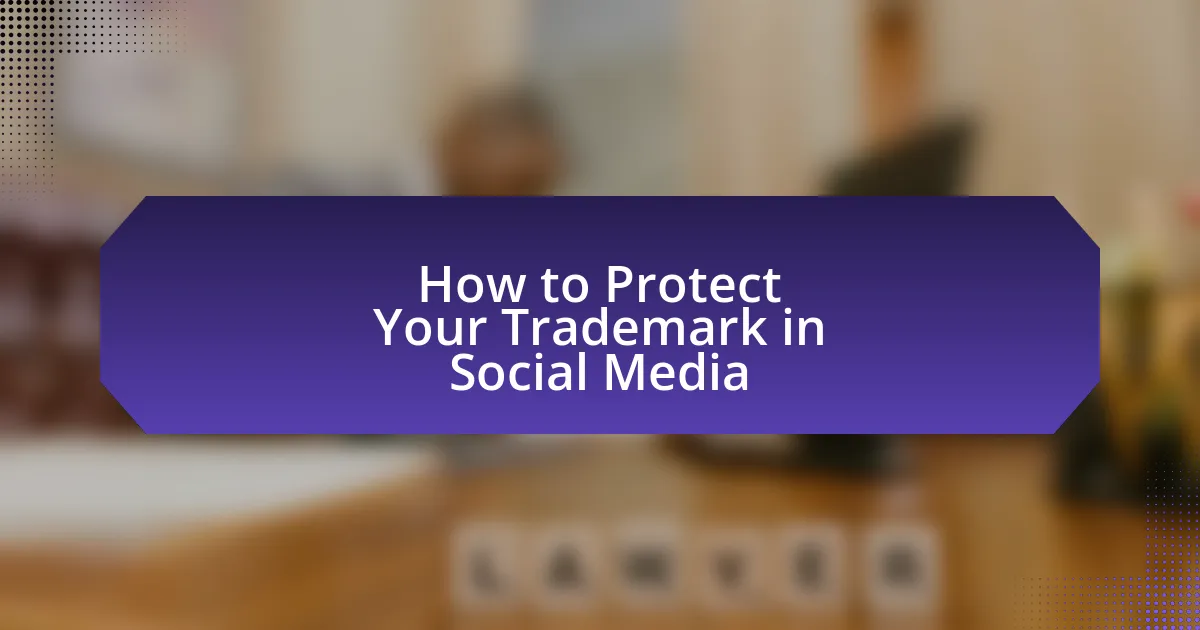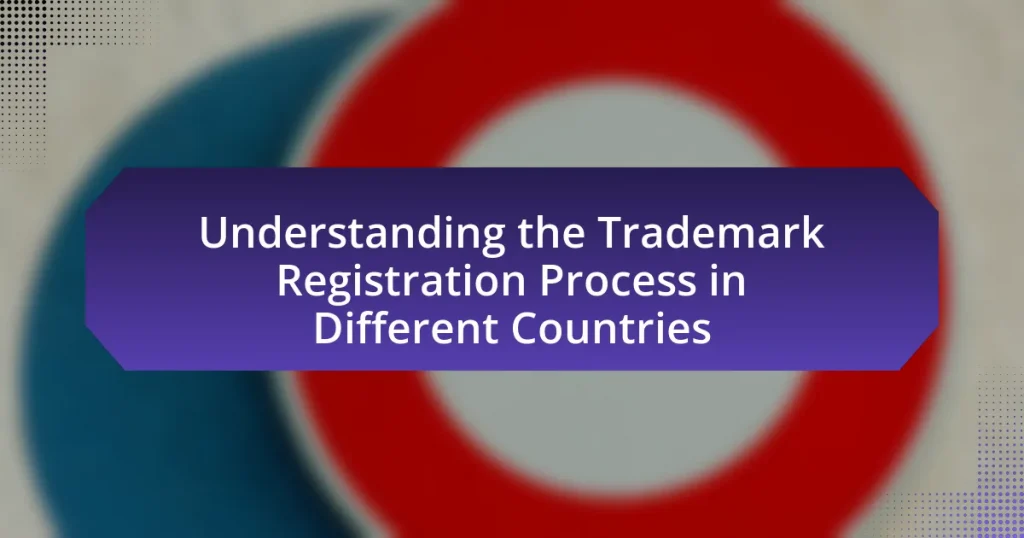Trademark protection in social media encompasses the legal measures that safeguard a brand’s name, logo, and identifiers from unauthorized use on platforms like Facebook and Twitter. This protection is vital for maintaining brand integrity and preventing consumer confusion, as 83% of consumers recognize brands through their trademarks. The article outlines the importance of trademark protection, the risks trademarks face on social media, and the steps businesses can take to monitor and enforce their trademark rights effectively. Key elements of trademark protection, the registration process, and best practices for maintaining brand integrity in the digital space are also discussed, providing a comprehensive guide for businesses navigating trademark issues in social media.
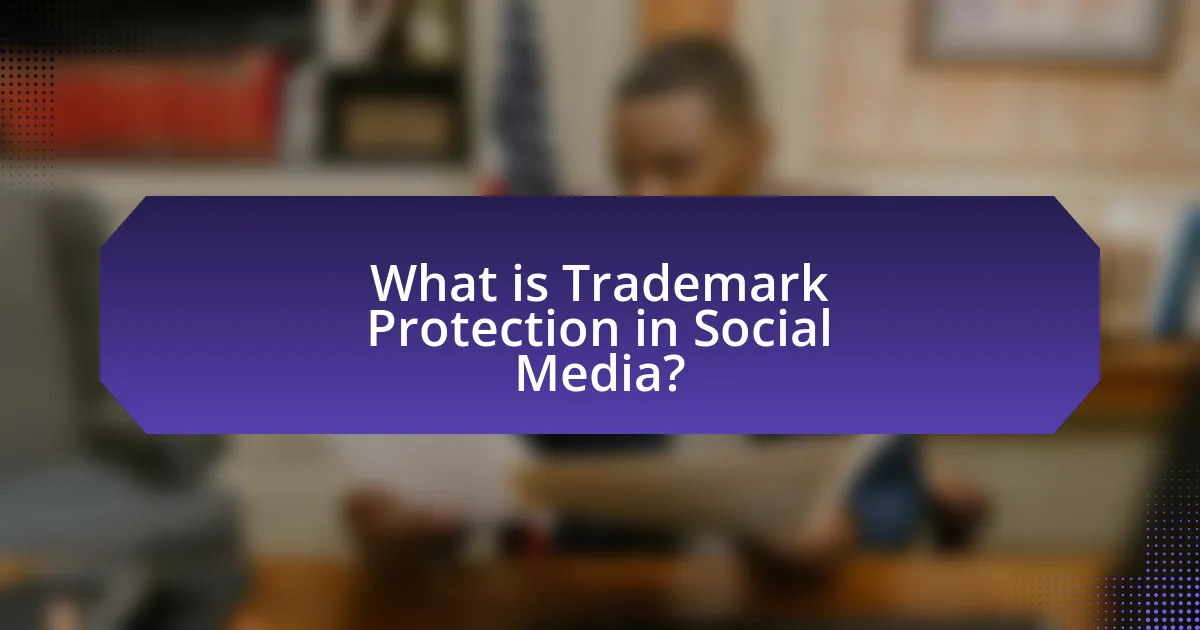
What is Trademark Protection in Social Media?
Trademark protection in social media refers to the legal safeguards that prevent unauthorized use of a brand’s name, logo, or other identifiers on social media platforms. This protection is crucial as it helps maintain brand integrity and prevents consumer confusion. Social media users can file complaints with platforms like Facebook or Twitter if they encounter trademark infringement, and these platforms often have policies in place to address such issues. Additionally, trademark registration with the United States Patent and Trademark Office (USPTO) or equivalent bodies in other countries enhances legal standing in disputes, providing stronger enforcement options against infringers.
Why is Trademark Protection Important in Social Media?
Trademark protection is important in social media because it safeguards brand identity and prevents unauthorized use of trademarks. Social media platforms are highly visible and can amplify brand recognition, making it essential for businesses to protect their trademarks from infringement and dilution. According to a 2021 report by the International Trademark Association, 83% of consumers recognize brands through their trademarks, highlighting the need for protection to maintain consumer trust and brand integrity. Additionally, trademark protection allows businesses to take legal action against counterfeiters and imposters, ensuring that their reputation remains intact in the digital space.
What risks do trademarks face on social media platforms?
Trademarks face several risks on social media platforms, including infringement, dilution, and misrepresentation. Infringement occurs when unauthorized users exploit a trademark, potentially leading to consumer confusion and brand damage. Dilution happens when a trademark’s distinctiveness is weakened due to its use in unrelated contexts, which can diminish brand value. Misrepresentation involves the unauthorized use of a trademark to falsely endorse products or services, misleading consumers. According to a 2021 report by the International Trademark Association, 70% of brand owners reported encountering trademark infringement on social media, highlighting the prevalence of these risks.
How can social media misuse affect brand reputation?
Social media misuse can significantly damage brand reputation by spreading misinformation, fostering negative perceptions, and amplifying customer dissatisfaction. When brands fail to monitor their social media presence, false claims or inappropriate content can go viral, leading to public backlash. For instance, a study by the University of Massachusetts found that 70% of consumers are influenced by negative online reviews, which can stem from social media interactions. Additionally, brands that do not respond promptly to negative comments may appear unresponsive or indifferent, further eroding trust. This erosion of trust can result in decreased customer loyalty and a decline in sales, as consumers increasingly rely on social media to inform their purchasing decisions.
What are the key elements of Trademark Protection?
The key elements of Trademark Protection include distinctiveness, use in commerce, and registration. Distinctiveness ensures that a trademark is capable of identifying the source of goods or services, which is essential for legal protection. Use in commerce requires that the trademark is actively used in the marketplace, establishing a connection between the mark and the goods or services offered. Registration with the appropriate governmental authority, such as the United States Patent and Trademark Office, provides legal advantages, including nationwide protection and the presumption of ownership. These elements collectively form the foundation of effective trademark protection, enabling businesses to safeguard their brand identity and prevent unauthorized use.
What constitutes a trademark in the context of social media?
A trademark in the context of social media constitutes any recognizable sign, design, or expression that identifies and distinguishes products or services of one entity from those of others. This includes brand names, logos, slogans, and even specific hashtags that are used consistently to represent a brand. The legal protection of these trademarks is essential, as it helps prevent unauthorized use by others, which can lead to brand dilution or consumer confusion. According to the United States Patent and Trademark Office, trademarks must be distinctive and used in commerce to qualify for protection, ensuring that consumers can reliably identify the source of goods or services.
How do trademark laws apply to social media content?
Trademark laws apply to social media content by protecting brand identifiers from unauthorized use that could cause confusion among consumers. Social media platforms are considered public spaces where trademarks can be displayed, but using a trademarked name, logo, or slogan without permission can lead to legal consequences, including cease-and-desist orders or lawsuits. For instance, the Lanham Act in the United States provides a framework for trademark protection, which extends to online content, ensuring that brands can defend their trademarks against infringement on social media.
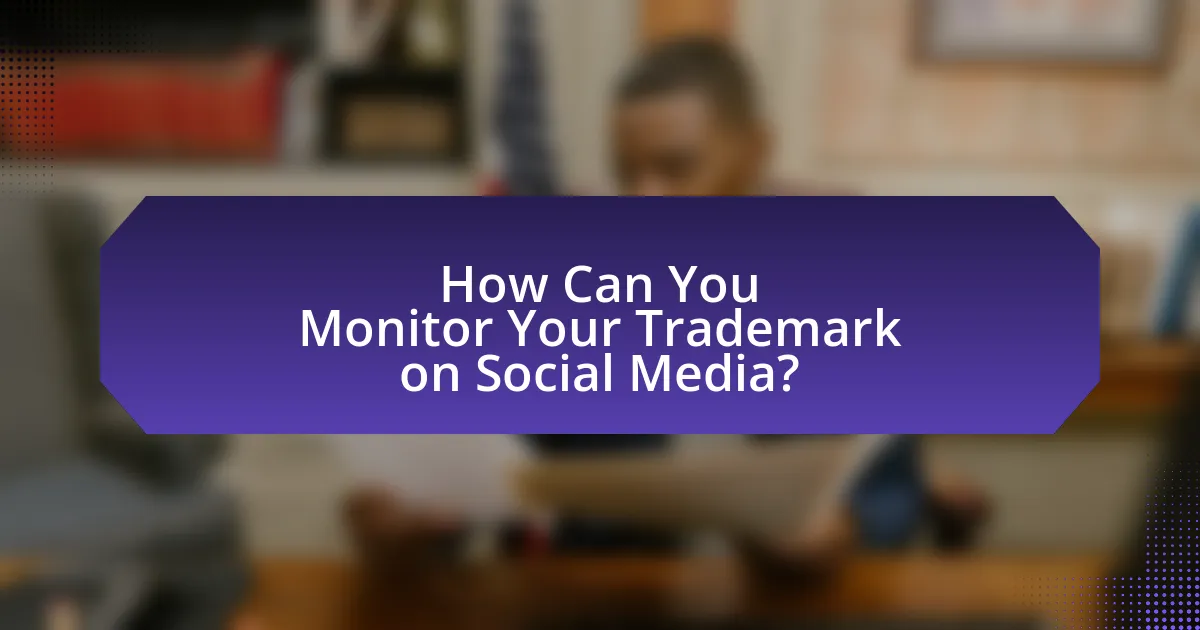
How Can You Monitor Your Trademark on Social Media?
To monitor your trademark on social media, utilize social listening tools that track mentions of your trademark across various platforms. These tools, such as Hootsuite, Brandwatch, or Mention, allow you to set up alerts for specific keywords related to your trademark, enabling you to identify unauthorized use or infringement. According to a report by Statista, 54% of social media users engage with brands, making it crucial to actively monitor these channels for potential trademark violations. Regularly reviewing user-generated content and engaging with your audience can also help in identifying misuse of your trademark.
What tools are available for trademark monitoring on social media?
Tools available for trademark monitoring on social media include Brand24, Mention, and Hootsuite. Brand24 provides real-time monitoring of brand mentions across various social media platforms, allowing users to track unauthorized use of trademarks. Mention offers similar capabilities, enabling users to receive alerts for brand mentions and analyze sentiment. Hootsuite allows users to manage multiple social media accounts and monitor brand mentions, providing insights into potential trademark infringements. These tools are widely recognized for their effectiveness in helping businesses protect their trademarks online.
How do these tools help in identifying trademark infringements?
These tools assist in identifying trademark infringements by utilizing algorithms that scan online content for unauthorized use of registered trademarks. They analyze text, images, and logos across various platforms, comparing them against a database of protected trademarks. For instance, tools like TrademarkNow and Markify employ machine learning to detect potential infringements, providing alerts when similar marks are found in use. This capability is crucial as it enables trademark owners to take timely action against unauthorized usage, thereby protecting their brand integrity and market position.
What are the best practices for using monitoring tools effectively?
The best practices for using monitoring tools effectively include setting clear objectives, selecting the right tools, and regularly analyzing the data collected. Establishing specific goals, such as tracking brand mentions or competitor activity, ensures that monitoring efforts are focused and relevant. Choosing tools that align with these objectives, such as social media analytics platforms or brand monitoring software, enhances the effectiveness of the monitoring process. Additionally, consistent analysis of the gathered data allows for timely responses to potential trademark infringements and helps in adjusting strategies based on insights gained. These practices are supported by industry standards, which emphasize the importance of targeted monitoring in protecting intellectual property online.
How often should you monitor your trademark on social media?
You should monitor your trademark on social media at least once a day. Daily monitoring allows for timely detection of potential infringements or misuse of your trademark, which is crucial for protecting your brand’s reputation. According to a study by the International Trademark Association, brands that actively monitor their trademarks can reduce the risk of infringement by up to 30%. Regular checks help ensure that any unauthorized use is addressed promptly, safeguarding your intellectual property effectively.
What factors influence the frequency of monitoring?
The frequency of monitoring is influenced by the level of brand activity on social media, the volume of user-generated content, and the potential for trademark infringement. Brands with high engagement or frequent posts require more regular monitoring to protect their trademarks effectively. Additionally, a higher volume of user-generated content increases the likelihood of unauthorized use of trademarks, necessitating more frequent checks. The risk of trademark infringement also dictates monitoring frequency; industries with a history of infringement or high competition may require more vigilant oversight to safeguard brand integrity.
How can timely monitoring prevent potential issues?
Timely monitoring can prevent potential issues by allowing businesses to identify and address trademark infringements or misuse of their brand in real-time. This proactive approach enables companies to respond swiftly to unauthorized use, thereby minimizing damage to their reputation and financial losses. For instance, a study by the International Trademark Association found that brands that actively monitor their trademarks online can reduce infringement incidents by up to 30%. By implementing timely monitoring strategies, businesses can safeguard their intellectual property and maintain brand integrity in the competitive social media landscape.
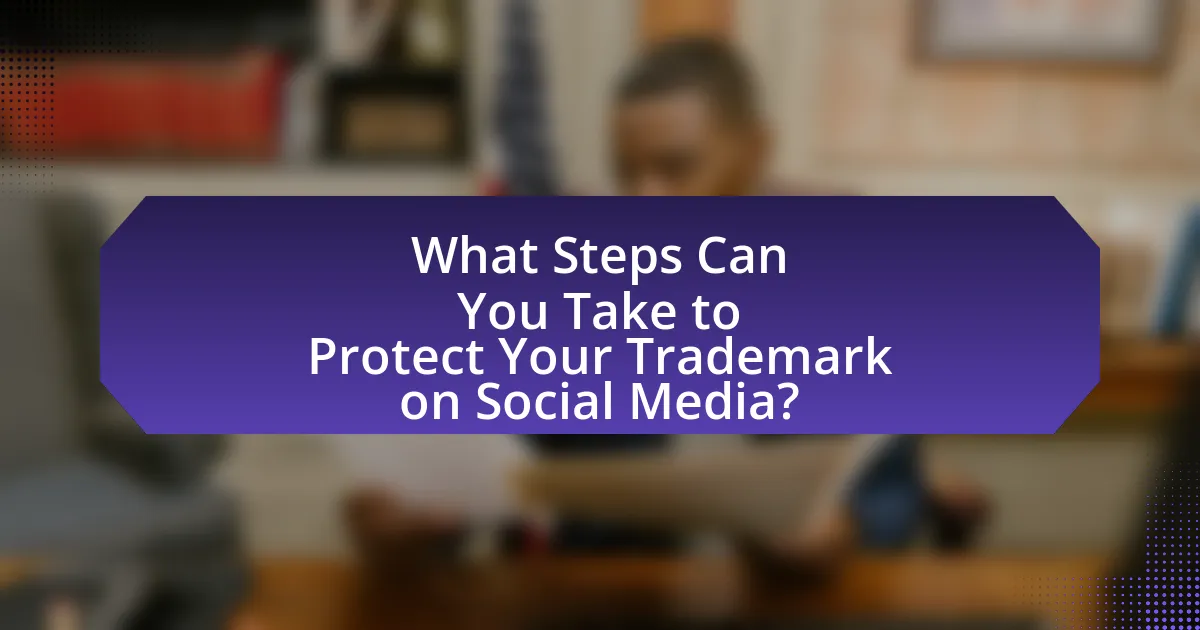
What Steps Can You Take to Protect Your Trademark on Social Media?
To protect your trademark on social media, you should register your trademark with the appropriate authorities and monitor social media platforms for unauthorized use. Registering your trademark provides legal recognition and strengthens your claim against infringement. Monitoring involves regularly checking for any unauthorized use of your trademark, which can be done through social media listening tools or manual searches. Additionally, you should actively engage with your audience to build brand loyalty, making it easier to identify and address potential infringements. Taking these steps helps safeguard your trademark and maintain your brand’s integrity in the digital space.
How can you register your trademark for social media use?
To register your trademark for social media use, you must file an application with the United States Patent and Trademark Office (USPTO) or the relevant trademark authority in your country. This process involves selecting the appropriate trademark class that corresponds to your goods or services, completing the application form, and paying the required fees. The USPTO provides guidelines and resources to assist applicants in ensuring their trademarks are distinctive and not already in use, which is crucial for successful registration. According to the USPTO, a registered trademark grants exclusive rights to use the mark in commerce, thereby protecting your brand identity on social media platforms.
What is the process for trademark registration?
The process for trademark registration involves several key steps. First, an applicant must conduct a trademark search to ensure that the desired mark is not already in use or registered by another entity. Next, the applicant files a trademark application with the relevant government authority, such as the United States Patent and Trademark Office (USPTO) in the United States, providing details about the mark and its intended use. After submission, the application undergoes examination by a trademark examiner, who assesses its compliance with legal requirements. If approved, the mark is published for opposition, allowing third parties to contest the registration. If no opposition is filed or if any opposition is resolved in favor of the applicant, the trademark is registered, granting the owner exclusive rights to use the mark in commerce. This process is supported by legal frameworks, such as the Lanham Act in the U.S., which governs trademark registration and protection.
What documentation is required for registration?
To register a trademark, the required documentation typically includes a completed application form, a representation of the trademark, and proof of use or intent to use the trademark in commerce. The application form must detail the trademark owner’s information and the goods or services associated with the trademark. Proof of use can be demonstrated through labels, packaging, or advertisements showing the trademark in use. This documentation is essential for the trademark office to assess the application and ensure compliance with legal requirements.
What actions can you take if your trademark is infringed upon?
If your trademark is infringed upon, you can take legal action by sending a cease-and-desist letter to the infringer. This letter formally requests that the infringer stop using your trademark and can serve as a precursor to further legal action if they do not comply. Additionally, you may file a complaint with the relevant trademark office or pursue litigation in court to seek damages and enforce your rights. According to the United States Patent and Trademark Office, taking prompt action is crucial in protecting your trademark rights and preventing further infringement.
How do you report trademark infringement on social media platforms?
To report trademark infringement on social media platforms, users must typically locate the platform’s reporting feature, often found in the help or support section. Each platform, such as Facebook, Instagram, or Twitter, provides specific guidelines and forms for reporting intellectual property violations, including trademark infringement. For instance, Facebook requires users to fill out a form detailing the infringement and provide evidence of trademark ownership, such as registration documents. This process is crucial as it allows the platform to assess the validity of the claim and take appropriate action, which may include removing the infringing content or disabling the infringer’s account.
What legal options are available for trademark enforcement?
Legal options for trademark enforcement include filing a trademark infringement lawsuit, seeking a cease-and-desist letter, and pursuing alternative dispute resolution methods such as mediation or arbitration. A trademark infringement lawsuit allows the trademark owner to seek damages and injunctive relief against the infringer, as established in cases like Polaroid Corp. v. Polarad Electronics Corp., which set a precedent for evaluating likelihood of confusion. A cease-and-desist letter serves as a formal request to the infringer to stop using the trademark, often leading to resolution without litigation. Alternative dispute resolution methods provide a less formal avenue for resolving disputes, which can be quicker and less costly than court proceedings.
What are some best practices for maintaining trademark protection on social media?
To maintain trademark protection on social media, businesses should consistently monitor their brand usage, actively enforce their rights, and educate their audience about their trademarks. Regularly searching for unauthorized use of trademarks helps identify potential infringements, while promptly addressing these issues through cease-and-desist letters or legal action reinforces the brand’s rights. Additionally, creating clear guidelines for the use of trademarks by third parties, such as influencers or partners, ensures that the brand is represented accurately and consistently. Educating followers about the correct usage of trademarks fosters brand loyalty and awareness, further protecting the trademark’s integrity.
How can you educate your audience about your trademark rights?
To educate your audience about your trademark rights, you can create informative content that clearly explains what trademark rights are, how they function, and the importance of protecting them. This can include articles, infographics, and videos that outline the legal definitions, the registration process, and the consequences of infringement. For instance, the United States Patent and Trademark Office (USPTO) provides resources that detail the benefits of trademark registration, which can serve as a reliable reference for your audience. Additionally, hosting webinars or Q&A sessions can facilitate direct engagement, allowing your audience to ask questions and gain a deeper understanding of trademark rights.
What role does consistent branding play in trademark protection?
Consistent branding plays a crucial role in trademark protection by reinforcing brand identity and distinguishing products or services in the marketplace. When a brand maintains uniformity in its visual elements, messaging, and overall presentation, it strengthens consumer recognition and loyalty, which are essential for establishing trademark rights. Research indicates that brands with consistent messaging are 3 to 4 times more likely to experience brand visibility and consumer trust, thereby enhancing their legal standing in trademark disputes. This consistency helps prevent dilution and infringement by making it easier for consumers to associate specific goods or services with a particular brand, ultimately supporting the brand’s legal claims to its trademark.
